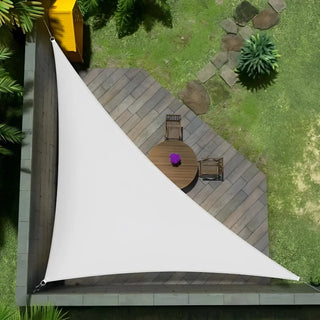Shade Sail Size Calculator
Calculate the perfect shade sail size for your space thanks to our online calculator. Simply enter the shape and measurements of your shape, and get instant recommendations for your shade sail installation.
Recommended Shade Sail Size
Important: This calculation accounts for 1-3 feet of tensioning space on each corner for proper installation.
Our shade sails by shape
How to use this shade sail calculator?
Getting the perfect shade sail for your outdoor space starts with accurate measurements. This guide will walk you through everything you need to know about measuring your area and using our calculator to find the ideal sail dimensions for your project.
How to measure your space for a shade sail
What you need before using our calculator
Before you start, grab a few essential tools. You'll need a tape measure, your smartphone, and ideally a helper to hold the other end of the measuring tape. The best time to measure is during calm weather conditions when there's no wind affecting your movement or accuracy.
Safety should be your first priority. If you need to measure high mounting points, use a sturdy ladder and have someone spot you. Never attempt to measure alone when working at height. Take your time and don't rush the process.
Make sure you have a pen and paper to record your measurements. You'll be entering this data into our calculator, so keeping accurate records is essential for getting the right results.
Step-by-step measuring instructions
Start by walking around your outdoor space and identifying potential anchor points. These could be walls, existing posts, trees, or locations where you plan to install new mounting hardware. Mark each point clearly so you don't lose track of them.
Now comes the critical part: measuring distances between your chosen anchor points. Always measure in a straight line between points, even if there are obstacles in between. Your shade sail will create a straight line of fabric between these anchor points.
Record the length, width, and any diagonal measurements. Don't forget to note the height of each mounting point. This data helps you understand how your sail will look and perform in your space.
Here's a pro tip: use your smartphone's measuring apps as backup. Many phones now have built-in measurement tools that work surprisingly well for outdoor spaces. They're perfect for double checking your tape measure results.
When measuring, step back and visualize how the sail will look. Consider the curve the fabric will create and how it will affect the usable space underneath.
Measuring tricky spaces
Not all outdoor spaces are perfect rectangles. If you're dealing with an L-shaped area, break it down into smaller sections. Measure each section separately, then decide if you want one large sail or multiple smaller ones.
Sloped ground presents its own challenges. Always measure the actual distance your sail will span, not the ground distance. If your anchor points are at different heights, this becomes even more important for proper tension.
Working around pools, trees, and existing structures requires extra planning. You want your sail to clear these obstacles safely. Add extra space in your measurements to account for the sail's curve and movement in wind.
For irregularly shaped areas, consider how different sail shapes might work. A triangle sail might fit better in some spaces, while a four-sided sail could provide better coverage in others.
Using our calculator: Step-by-step guide
Entering your measurements
Using our shade sail calculator is straightforward. You'll see input fields for your measurements. Enter the distances between anchor points in the length and width fields carefully.
When you select your preferred shape, think about your space and needs. Triangle sails work great for three-sided areas and provide excellent tension. Four-sided sails cover more area but need four strong anchor points.
Take your time entering each measurement. If you're unsure about a measurement, go back outside and double check it.
The calculator will ask for basic information about your space shape and dimensions. Make sure you select the right shape option that matches your intended anchor point layout.
Understanding your results
Our calculator provides a recommended sail size range by automatically subtracting 1 to 3 feet (0.3 to 0.9 meters) from your measurements at each anchor point. This spacing ensures proper tension and creates the attractive curve that makes shade sails structurally sound.
The calculator provides a range of suitable sizes rather than just one exact dimension. This gives you flexibility to choose based on your aesthetic preferences and our available inventory.
You'll see our standard sizes that fall within your calculated range. These are the most cost-effective options since they're part of our regular production. The calculator will also note if your space might require custom dimensions.
When to contact us for custom sizing
If your calculated range falls outside our standard sizes, the calculator will recommend contacting our team. We can discuss custom options or suggest alternative approaches like multiple smaller sails.
Large or unusually shaped spaces often require custom solutions. Our team can help you understand whether a single custom sail or multiple standard sails would work better for your project.
Don't worry if the standard sizes don't seem perfect. Our team can help you understand the trade-offs between different options and find the best solution for your specific needs.
Breaking down large or complex spaces
Multiple sails for large areas
Sometimes one large sail isn't the best solution for your outdoor space. Large areas often benefit from multiple smaller sails that provide better coverage and visual interest.
Multiple sails offer several advantages. They're easier to install, create more interesting shadow patterns, and allow for better airflow. They also cost less than a single oversized custom sail.
When planning multiple sails, think about how they'll work together. Overlapping coverage areas ensure no gaps in shade during different times of day as the sun moves.
The calculator can help you plan each sail separately. Measure and calculate each section of your space individually, then coordinate the sizes and colors for a cohesive look.
Creative design approaches
Breaking rectangles into triangles creates visual depth and can help define separate areas within your outdoor space. Triangle sails also handle wind better than large rectangular ones.
You might use triangular sails over seating areas and rectangular ones over dining spaces. This approach creates distinct zones while maintaining overall design coherence.
Different sail shapes can highlight architectural features or complement your landscape design. Consider how the angles and curves will interact with your existing outdoor elements.
Color coordination across multiple sails ties the whole design together. You might choose different shades of the same color or complementary colors that enhance your outdoor aesthetic.
Planning multi-sail layouts
When planning multiple sails, ensure adequate spacing between them. Generally, leave at least 2-3 feet between sail edges to prevent them from touching in wind.
Consider the movement each sail will have in normal wind conditions. Sails that are too close together can interfere with each other and create wear points.
Think about the installation sequence too. Some anchor points might be shared between sails, which can complicate the tensioning process if not planned properly.
Our calculator can help you plan each sail in your layout. Work through each one systematically, then contact us to discuss the overall project and any shared anchor points.
Smart measuring tips and troubleshooting
Double checking your measurements
Even experienced DIY enthusiasts make measuring mistakes. Common errors include measuring to the wrong points or forgetting to account for obstacles that affect sail placement.
Photo-based measuring apps can help verify your tape measure results. These apps use your phone's camera and built-in sensors to estimate distances. While not as accurate as a tape measure, they're great for confirming your measurements are reasonable.
If your measurements don't seem right when you enter them into the calculator, step back and review your work. Sometimes a simple mistake can throw off the entire result.
Try measuring the same distance twice to ensure consistency. If you get different results, take a third measurement and use the most consistent value.
Getting accurate results from the calculator
Remember that calculated dimensions might look different than you expected in your actual space. Shade sails have a distinctive shape and curve that can be hard to visualize beforehand.
Consider seasonal conditions when reviewing your calculated size range. A sail that seems perfect in winter might feel too large or small when summer arrives and you're using your outdoor space more intensively.
Weather and wind conditions in your area affect how your sail will perform. If you live in a particularly windy location, staying toward the smaller end of your calculated range might be wise.
Think about how the sail will look from inside your house too. The view from indoors can be quite different from the view while standing underneath the sail.
Finding prices for your calculated size
Checking prices on our website
Once you have your calculated size range, you can find pricing by visiting our shade sails collection. Select your preferred color and shape, then choose the dimensions that match your calculated range.
Pricing varies by size only, all colors are the same price for each dimension. You'll see different price points for different sizes within your range, helping you balance coverage with budget. Sometimes a slightly smaller sail offers significantly better affordability.
The online catalog shows our complete range of standard sizes and colors. If you don't see exactly what you need, that's when to contact us for a custom quote.
Getting custom quotes
If your calculated size falls outside our standard range, or if you need multiple sails for a complex project, contact us directly for a custom quote.
Custom sizing allows us to optimize the sail for your exact space requirements. This option makes sense for unusual shapes or very large areas that don't fit standard dimensions.
When requesting a custom quote, provide your calculator results along with any special requirements. This helps us prepare an accurate estimate and suggest the best approach for your project.
Our team can also help you plan multi-sail projects and coordinate colors and sizes across multiple sails for a cohesive design.
Understanding our waterproof HDPE material
Why we chose HDPE fabric
Our shade sails are made from high-quality waterproof HDPE (high-density polyethylene) fabric. This material offers the perfect balance of durability, UV protection, and weather resistance for outdoor applications.
HDPE fabric blocks harmful UV rays while providing excellent longevity in all weather conditions. The waterproof properties mean your sail provides protection from both sun and rain.
This commercial grade material maintains its strength and color over time, even in harsh outdoor conditions. The fabric is designed to handle the stress of proper tensioning without stretching or tearing.
Our HDPE sails are easy to clean and maintain. The smooth surface sheds dirt and debris naturally, and occasional hosing keeps them looking fresh.
Color options and performance
We offer multiple color options in our waterproof HDPE fabric. Each color provides the same excellent UV protection and weather resistance.
Lighter colors reflect more heat and can help keep the area underneath cooler. Darker colors absorb more heat but may provide better visual contrast with your outdoor design.
All our colors are fade-resistant and designed to maintain their appearance over years of outdoor exposure. The UV-resistant pigments ensure consistent color performance.
Consider your local climate and aesthetic preferences when choosing colors. Our team can help you select colors that work well together if you're planning multiple sails.
Planning for installation (DIY guidance)
Anchor point requirements
Your anchor points need to handle significant force, especially in windy conditions. Concrete walls, steel posts, and large trees typically provide adequate strength for residential installations.
Each anchor point should be able to handle at least 200-300 pounds of force in multiple directions. This ensures safety even in unexpected wind conditions.
Avoid mounting to weak structures like thin fence posts, lightweight pergolas, or small trees. These mounting points can fail and damage both your sail and surrounding property.
When in doubt about anchor point strength, consult with a local contractor or structural engineer. It's better to invest in proper mounting hardware than risk safety issues later.
Installation planning basics
Creating the right tension requires careful attention to the order of attachment and the amount of curve in your sail. Start with one corner and work systematically around the sail.
Plan for about 6-12 inches of curve (sag) in each direction for optimal performance and appearance. Too little curve creates excessive stress, while too much reduces the sail's effectiveness.
For most installations, you can add our complete hardware kit to your cart. The hardware kit contains everything needed for a standard installation:
- 2 turnbuckles to create tension in 2 corners
- 2 carabiners for the remaining corners
- 4 pad eyes to create sturdy anchor points
Weather conditions affect installation timing. Avoid installing during windy conditions, and allow extra time for proper tensioning and adjustment.
Calculator limitations and when to contact us
What our calculator handles well
Our calculator works best for standard residential installations with typical anchor point configurations. It provides reliable sizing recommendations for most common outdoor spaces.
The tool is designed for straightforward rectangular and triangular configurations. These shapes cover the majority of residential shade sail applications effectively.
Standard residential spaces with normal clearance requirements work perfectly with our calculator. The tool accounts for proper tensioning space and standard installation practices.
When to reach out to our team
Complex situations may require individual consultation with our team. Very large spaces, unusual shapes, or specific architectural requirements often benefit from personal consultation.
If your space requires custom dimensions outside our standard size range, contact us directly. We can discuss options and provide pricing for custom work.
Multi-sail projects with shared anchor points or complex layouts benefit from professional planning. Our team can suggest creative solutions that online tools can't provide.
Building code requirements vary by location and application. While our calculator provides general guidance, always check local requirements for your specific project.
After using the calculator: Next steps
Reviewing your results
Before making your purchase decision, review the size recommendations and consider how they'll work in your specific space. Make sure the dimensions make sense for your intended use.
Double check that you've selected the right shape and that your measurements are accurate. It's much easier to correct errors now than after you've received your sail.
Consider factors like color preference and budget as you review your options. The calculator provides the technical framework, but personal preferences matter too.
Save your calculator results if you need time to think about your decision. You can return to review the recommendations or share them with family members.
Making your purchase
For standard sizes, visit our shade sails collection to select your preferred color and dimensions. You can select your desired hardware from our hardware collection or choose the complete hardware kit directly. The ordering process is straightforward.
For custom sizes or special requirements, contact our team directly. We'll work with you to finalize specifications and provide accurate pricing and timing.
We'll need your exact measurements and any special requirements when you place a custom order. Having your calculator results handy speeds up this process.
Typical delivery time runs 1-2 weeks for standard sizes and 2-4 weeks for custom orders. We'll provide specific timing when you place your order.
Getting the most from your new shade sail
Once your sail arrives, take time to read the our full installation guide if you're not sure about installation. Proper setup ensures optimal performance and longevity.
Plan to adjust tension seasonally as weather conditions change. Fabric naturally responds to temperature changes, so minor adjustments are normal.
Consider how you might expand your shade system in the future. If you love your first sail, you might want to add complementary sails to other areas of your outdoor space.
Keep records of your sail specifications and installation details. This information helps if you need replacement hardware or want to order additional sails that coordinate with your current setup.
Ready to get started? Grab your measuring tape and use our calculator to design the perfect shade solution for your outdoor space. With accurate measurements and our easy-to-use tool, you'll have the right sail size recommendations in just a few minutes.





